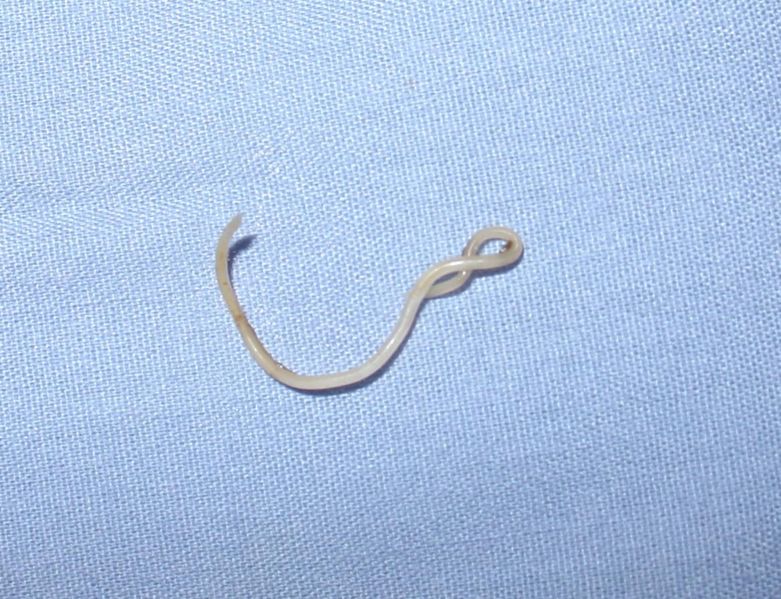Toxocariasis
| Toxocariasis | |
 | |
|---|---|
| Toxocara canis | |
| ICD-10 | B83.0 (ILDS B83.01) |
| ICD-9 | 128.0 |
| DiseasesDB | 29739 |
| eMedicine | med/2293 ped/2270 |
| MeSH | D014120 |
Toxocariasis is an infection caused by the dog or cat roundworm, Toxocara canis or Toxocara cati, respectively. Ingestion of these worms causes the condition, visceral larval migrans (VLM) and Ocular larvae migrans (OLM).
Epidemiology
Toxocariasis occurs around the world. Epidemiologic surveys show a 2-5% positive rate in healthy adults from urban Western countries and 14.2-37% in rural areas.[1] In tropical countries, surveys show a positive rate of 63.2% in Bali, 86% in Saint Lucia, and 92.8% in Réunion.[1] Toxocariasis is most commonly a disease of children, typically children aged 2-7 years.
Risk factors
- Exposure to contaminated soil.
- Presence of unwormed pups, unhygenic conditions.
- Geophagia (pica)- 2-10% of children aged 1-3 indulge in habitual geophagia.
Pathophysiology
Adult worms of the Toxocara family often live in the small intestine of dogs and cats. They range from 4-12 cm in length. Almost all puppies are infected at or soon after birth. During the summer, Toxocara infective eggs are shed. They survive for years in the environment, and humans typically ingest the eggs orally by eating with contaminated hands. Once introduced into the human intestine, the eggs develop into larvae. The larval form is less than 0.5 mm in length and 0.02 mm wide. The larvae penetrate the bowel wall and migrate through blood vessels to reach the liver, muscles, and lungs. Sometimes the parasite penetrates into the eye and brain.
Disease severity is affected by the number of eggs ingested, duration of infection, tissue location of larvae, and the immune response to the infection.
Features
- Weakness
- Pruritus (Itching)
- Rash
- Difficulty breathing
- Abdominal pain / Hepatosplenomegaly
- Hyper-eosinophilia
- Increased total serum Immunoglobulin E (IgE) level
- Elevated antibody titers to T. canis
Diagnosis
In suspected cases, diagnosis is confirmed by an increase in the anti-Toxocara excretory-secretory antigen IgE level
History of exposure to dogs and cats
High Sustained eosinophilia + hyperglobulinemia + hepatomegaly
Liver Biopsy shows degenerated larvae at the centre of an eosinophilic granuloma
Treatment
Anthelmintic treatment, e.g. mebendazole, thiobendazole and diethylcarbamazine. Albendazole is the more modern form of treatment.
Management with anti-inflammatory steroids is also an option.
Prognosis
Toxocariasis is always a benign, asymptomatic, and self-limiting disease, although brain involvement can cause brain damage, meningitis, encephalitis, or epilepsy. Ocular involvement, also known as 'ocular larvae migrans,' may cause loss of visual acuity or unilateral blindness. Pulmonary and hepatic forms can cause protracted symptoms if the patient does not receive treatment.
Prevention
The eggs of Toxocara species are widespread in parks, playgrounds, yards, and in homes and apartments where the occupants have dogs or cats. Elimination of eggs from the environment is not possible; therefore, prevention depends on proper hygiene, including handwashing after contact with pets. Public policies that have attempted to eradicate Toxocara infection in dogs and cats have had limited success.
References
- ↑ 1.0 1.1 Huh, Sun (2006). "Toxocariasis". eMedicine.com. Retrieved 2007-03-27. Unknown parameter
|coauthors=ignored (help)
External links
- CDC information page on toxocariasis.
- Roundworms: Cats and Kittens from The Pet Health Library
- Roundworms: Dogs and Puppies from The Pet Health Library
Template:Helminthiases Template:SIB id:Toksokariasis nl:Toxocariasis